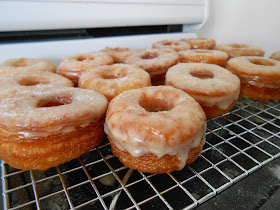So what is it?
It's croissant dough, cut into the shape of a doughnut, fried like a doughnut, and then frosted like a doughnut. Sometimes it might even get filled with cream or jam, like a doughnut.
For more information - here's an infographic about Cronuts.
Dominique Ansel and his crew invented the Cronut, but Auddino's Bakery in Ohio claims that they have been making croissant-doughnuts under the name Doughssants for 20 years. While the Cronut may be an exquisite example of a croissant-doughnut, I think it's important to note that this idea isn't new. Fried dough is an inherent part of human nature. It was a logical step once we had invented fire, pottery, oil, and dough (at least 7,000 years ago). Fried dough is a common thread connecting all cultures, regardless of class. Check out Wikipedia's list of fried doughs of the world!
So why all the Cronut hype? Why not! Who doesn't love a good fried dough? Though I'm not going to make the 3000 mile trip solely for a pastry. Nor am I going to pay $100 to have one shipped to me. I could also use this interactive map to find the nearest croissant-doughnut, but it's just so much more fun to try and make it myself.
I started with my favorite croissant dough recipe, which I managed to spread out over an entire week. (Saturday: make dough, Sunday: first fold, Tuesday: second fold, Thursday: third fold and cut out doughssants, Saturday: fry, Sunday: glaze) After the final fold, I rolled the dough out to 3/8 inch thick.
Then I used two ring cutters to make doughnut shapes.
I procrastinated and refrigerated these for two days, then I let them proof in my oven for 3-4 hours before frying. You can turn your oven into a proof box by filling a pan with boiling water. Don't turn the oven on! The steam and minor amount of heat from the water creates the perfect environment for rising dough.
After 3-4 hours, they should look puffed:
Heat up a liberal amount of grapeseed oil in a sturdy pot. I usually turn it on high for a minute to get it going, then leave it on low while I'm frying.
The proofed doussants are incredibly delicate, I found a pie server to be the most effective way to transfer each doughssant from the oven to the frying oil. Then tongs work well to fish them out. Let them drain and cool on a rack.
I changed the oil in between doughssants and doughssant holes. In the end I used a full 2 liters of oil, which may have been a little excessive, but when it comes to frying, it's always better to have too much oil than not enough.
The doughssant holes have low structural integrity. A mesh spoon (or spider) helps to get all the bits out.
I let the holes drain for a minute, then I coated them with cinnamon and sugar.
Mmmm delicious crunchy cinnamon and sugar holes!
In the end, my croissant dough recipe made 24 doughssants and about 60 doughssant holes. The doughssants should probably be glazed as soon as their cool and eaten immediately. I let mine sit overnight before glazing.
Doughnut Glaze
2 cups Powdered Sugar
1/2 cup Milk
1 tsp Vanilla Extract
...
Combine all ingredients in a metal bowl.
Place the bowl over a pot of boiling water to make a double boiler.
Whisk until smooth.
Dip doughnuts.
Let each dipped doughssant drain and cool on a rack. Before the glaze fully hardens, I sprinkled the dipped doughssants with edible sparkles.
In the end, these were delicious, but a bit tough and incredibly greasy. One of my fellow grad students declared that these are American Baklava. Next time I make these I think I'll try to make them more doughy and less croissanty by using less butter (or more flour) in the dough. The holes were arguably a lot better than the doughssants - they came out crisp and crunchy!


















